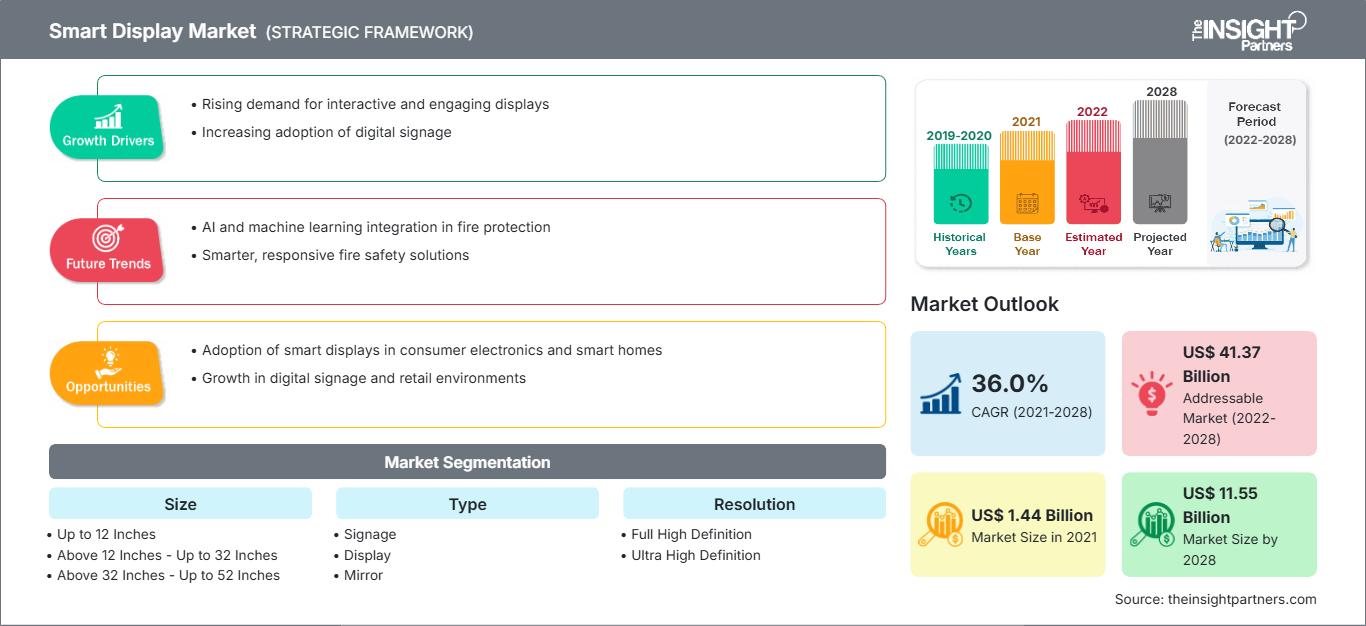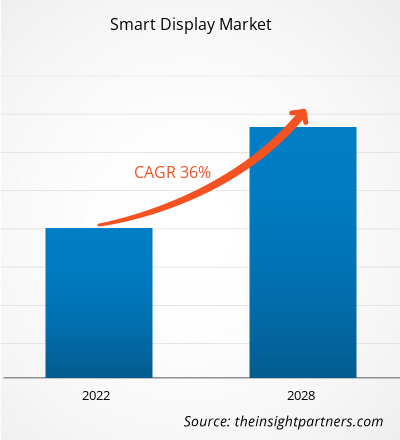El mercado de pantallas inteligentes se valoró en US$ 1.443,74 millones en 2021 y se espera que alcance los US$ 11.547,23 millones para 2028; se estima que registrará una CAGR del 36,0% de 2022 a 2028.
Una pantalla inteligente es una pantalla digital que se puede controlar mediante dispositivos de control remoto por voz o dispositivos conectados al Internet de las Cosas (IoT). Por ejemplo, un espejo inteligente es un dispositivo innovador que registra la información personal de los usuarios y la experiencia de compra en los sectores automotriz y minorista. Además, como solución técnica de vanguardia, la pantalla inteligente incluye funciones de control interactivas y complejas.
La gran demanda de espejos inteligentes en la industria automotriz, las características nuevas e innovadoras que ofrecen los espejos inteligentes, un número cada vez mayor de usuarios de Internet y la creciente adopción de dispositivos inteligentes según las preferencias de los consumidores, la creciente demanda de electrodomésticos inteligentes impulsados por IA y habilitados para IoT, la creciente tendencia de señalización consciente del contexto y la creciente adopción de señalización inteligente en el sector minorista son los factores impulsores clave que impulsan el crecimiento del mercado de pantallas inteligentes.
El creciente sector minorista se sustenta en el creciente poder adquisitivo de los consumidores. Además, la rápida expansión de los centros comerciales y los espacios minoristas en todo el mundo impulsa la demanda de soluciones de señalización inteligente para atraer a los transeúntes y animarlos a entrar en la tienda. Como resultado, las tiendas inteligentes están interesadas en utilizar la publicidad programática para aumentar el reconocimiento de marca. La señalización inteligente también puede utilizarse como parte del proceso de pago. Los clientes pueden pagar con un dispositivo móvil en lugar de hacer cola para pagar. Varios minoristas, como Walmart, Alibaba, Amazon y Carrefour, han establecido tiendas inteligentes en todo el mundo. Utilizan diversas soluciones y tecnologías de venta minorista inteligente, como la señalización inteligente, en las tiendas inteligentes. Los minoristas de todo el mundo han implementado estrategias de expansión y asociación para abrir tiendas más inteligentes y sin cajeros. Todos estos factores están impulsando el tamaño del mercado de las pantallas inteligentes.
Obtendrá personalización en cualquier informe, sin cargo, incluidas partes de este informe o análisis a nivel de país, paquete de datos de Excel, así como también grandes ofertas y descuentos para empresas emergentes y universidades.
Mercado de pantallas inteligentes: perspectivas estratégicas

-
Obtenga las principales tendencias clave del mercado de este informe.Esta muestra GRATUITA incluirá análisis de datos, desde tendencias del mercado hasta estimaciones y pronósticos.
Perspectivas del mercado de pantallas inteligentes
Presencia de marcas populares
Una vez que los clientes se acostumbran al producto de una marca en particular, compran otros productos de la misma marca. Algunas marcas conocidas, como Google; Amazon, Inc.; Bosch; Panasonic; BenQ Corporation; LG Electronics; Lenovo Group, Ltd.; Samsung Corporation; y Sony Corporation, ofrecen diversas soluciones de pantallas inteligentes para las industrias de automóviles, atención médica, residencial y minorista. Estas marcas atraen sin esfuerzo a sus clientes leales y son un factor impulsor importante para el crecimiento del mercado de pantallas inteligentes. Las marcas a veces promocionan sus productos antes del lanzamiento para crear expectación entre los clientes. Por ejemplo, en marzo de 2022, la pantalla inteligente 10 de Xiaomi se incluyó en varios sitios web y el producto se lanzó en abril de 2022. En enero de 2022, Google lanzó su pantalla inteligente Google Nest Hub de segunda generación en India a US$ 103,24. En junio de 2021, Amazon lanzó dos nuevos productos de pantalla inteligente en el mercado indio; el Echo Show 10 y el 5. Por lo tanto, la creciente popularidad de las marcas está impulsando el crecimiento del mercado de pantallas inteligentes.BenQ Corporation; LG Electronics; Lenovo Group, Ltd.; Samsung Corporation; and Sony Corporation, offer various smart display solutions for automobiles, healthcare, residential, and retail industries. These brands effortlessly attract their loyal customers and are a major driving factor for the growth of the smart display market. Brands sometimes promote their products before the launch to create hype among customers. For instance, In March 2022, Xiaomi’s smart display 10 was listed on multiple websites, and the product was launched in April 2022. In January 2022, Google launched its 2nd generation Google Nest Hub smart display in India at US$ 103.24. In June 2021, Amazon launched 2 new smart display products in the Indian market; the Echo show 10 and 5. Thus, the rising popularity of the brands is driving the growth of the smart display market.
Perspectivas del mercado basadas en el tamaño
Según el tamaño, el mercado de pantallas inteligentes se segmenta en hasta 12 pulgadas, a partir de 12 pulgadas, hasta 32 pulgadas, a partir de 32 pulgadas, hasta 52 pulgadas y a partir de 52 pulgadas. Los tamaños de pantalla varían según el fabricante. Si bien algunos fabricantes ofrecen mayor funcionalidad incluso en pantallas más pequeñas, otros prefieren variar la funcionalidad según el tamaño de la pantalla. El mercado se ve impulsado principalmente por la creciente demanda de pantallas de señalización inteligente de tamaño mediano en diversos mercados verticales a nivel mundial.
Perspectivas del mercado basadas en resoluciones
Según la resolución, el mercado de pantallas inteligentes se segmenta en Full High Definition (FHD), Ultra High Definition (UHD) y otras. Las pantallas inteligentes con resolución HD se utilizan principalmente en aplicaciones residenciales. Sin embargo, la mayoría de las demás aplicaciones, como la señalización publicitaria o los quioscos inteligentes, utilizan cada vez más pantallas con resoluciones UHD y FHD. El mercado se ve impulsado principalmente por la creciente demanda de pantallas de señalización inteligente con mejor resolución para que los usuarios puedan disfrutar de una experiencia inmersiva.
Los actores del mercado de pantallas inteligentes adoptan estrategias como fusiones, adquisiciones e iniciativas de mercado para mantener su posición en el mercado. A continuación, se enumeran algunos avances de los actores clave:
- La aplicación NoviSign Android Digital Signage ya está disponible para todas las pantallas Sony BRAVIA Professional con sistema operativo Android, según NoviSign, líder del sector y pionero en señalización digital Android. La línea profesional BRAVIA de Sony es compatible con 4K y HDR, cuenta con una plataforma de sistema en chip (SSC) y está disponible en tamaños que van desde las 32 hasta las 100 pulgadas.
- BenQ, líder en tecnologías de pantallas interactivas, se unió a la Iniciativa de Soluciones Integradas para la Educación de Google. Con esta iniciativa, BenQ mantiene su compromiso de ofrecer soluciones educativas que permitan a las escuelas construir entornos de aprendizaje activo más resilientes, adecuados tanto para la educación presencial como a distancia.
Perspectivas regionales del mercado de pantallas inteligentes
Los analistas de The Insight Partners han explicado detalladamente las tendencias regionales y los factores que influyen en el mercado de pantallas inteligentes durante el período de pronóstico. Esta sección también analiza los segmentos y la geografía del mercado de pantallas inteligentes en Norteamérica, Europa, Asia Pacífico, Oriente Medio y África, y Sudamérica y Centroamérica.
Alcance del informe de mercado de pantallas inteligentes
| Atributo del informe | Detalles |
|---|---|
| Tamaño del mercado en 2021 | 1.440 millones de dólares estadounidenses |
| Tamaño del mercado en 2028 | US$ 11.55 mil millones |
| CAGR global (2021-2028) | 36,0% |
| Datos históricos | 2019-2020 |
| Período de pronóstico | 2022-2028 |
| Segmentos cubiertos |
Por tamaño
|
| Regiones y países cubiertos |
América del norte
|
| Líderes del mercado y perfiles de empresas clave |
|
Densidad de actores del mercado de pantallas inteligentes: comprensión de su impacto en la dinámica empresarial
El mercado de pantallas inteligentes está creciendo rápidamente, impulsado por la creciente demanda del usuario final debido a factores como la evolución de las preferencias del consumidor, los avances tecnológicos y una mayor conciencia de las ventajas del producto. A medida que aumenta la demanda, las empresas amplían su oferta, innovan para satisfacer las necesidades del consumidor y aprovechan las tendencias emergentes, lo que impulsa aún más el crecimiento del mercado.

- Obtenga una descripción general de los principales actores clave del mercado de pantallas inteligentes
El mercado global de pantallas inteligentes se segmenta según tamaño, tipo, resolución e industria. Según el tamaño, el mercado se divide en hasta 12 pulgadas, a partir de 12 pulgadas, hasta 32 pulgadas, a partir de 32 pulgadas, hasta 52 pulgadas y a partir de 52 pulgadas. En cuanto al tipo, el mercado se segmenta en señalización, pantallas y espejos. Según la resolución, el mercado se segmenta en alta definición total, ultra alta definición y otros. Además, según la industria, el mercado de pantallas inteligentes se segmenta en electrodomésticos, automoción, comercio minorista, salud y otros.
Alphabet Inc.; Amazon.com, Inc.; LG Electronics; LENOVO GROUP LIMITED; Magna International Inc.; Panasonic Corporation; Sony Corporation; BenQ Corporation; NEXCOM International Co., Ltd.; y Samsung Electronics Co., Ltd. son los principales actores del mercado de pantallas inteligentes considerados en el estudio. Además, se han estudiado y analizado otros actores importantes del mercado en este informe para obtener una visión integral del mercado global de pantallas inteligentes y su ecosistema.
- Análisis histórico (2 años), año base, pronóstico (7 años) con CAGR
- Análisis PEST y FODA
- Tamaño del mercado, valor/volumen: global, regional y nacional
- Industria y panorama competitivo
- Conjunto de datos de Excel
Informes recientes
Informes relacionados
Testimonios
Razón para comprar
- Toma de decisiones informada
- Comprensión de la dinámica del mercado
- Análisis competitivo
- Información sobre clientes
- Pronósticos del mercado
- Mitigación de riesgos
- Planificación estratégica
- Justificación de la inversión
- Identificación de mercados emergentes
- Mejora de las estrategias de marketing
- Impulso de la eficiencia operativa
- Alineación con las tendencias regulatorias






















 Obtenga una muestra gratuita para - Mercado de pantallas inteligentes
Obtenga una muestra gratuita para - Mercado de pantallas inteligentes